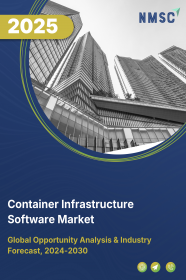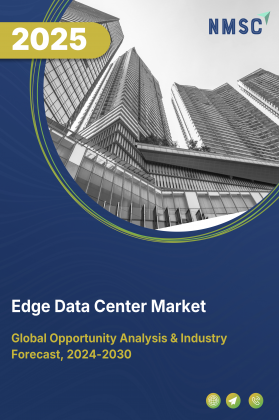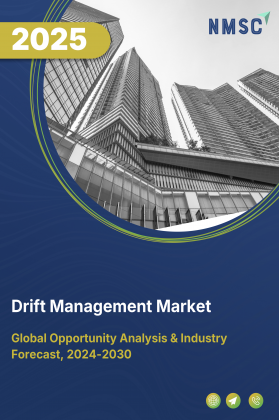
Container Infrastructure Software Market by Type of Containerization (Operating System-Level Virtualization, and Others), by Component (Container Orchestration Tools, Container Runtime, and Others), by Deployment Model (On-Premium, and Cloud), by Organization Size (Large Enterprises, Small Enterprises, and Others), by Application (Monitoring & Logging, Security, and Others), and by End-User (IT and Telecommunications, and Others) – Global Opportunity Analysis and Industry Forecast, 2024–2030
Market Definition
The Container Infrastructure Software Market size was valued at USD 2.51 billion in 2023 and is predicted to reach USD 7.18 billion by 2030 with a CAGR of 16.2% from 2024 to 2030. The container infrastructure software is a virtualized container that packages the code and all its dependencies so that the application runs quickly and reliably across computing environments. This container is a lightweight, standalone, executable package of software that includes everything needed to run an application such as codes, runtime, system tools, system libraries, and settings.
Software containers are available in many types including custom docker containers, certified managed containers, elastic virtual private servers (Elastic VPS), custom docker containers, docker engine CE (Docker Native), and kubernetes cluster container. In addition, software containers ensure better safety to applications along with best industry-standard isolation capabilities.
Market Dynamics and Trends
The increasing adoption of microservices architecture, which requires containers for microservices architecture for easy deployment, is expected to drive the growth of the container infrastructure software market. Also, government and healthcare sectors are adopting containerization to achieve compliance and regulatory requirements, as they have a massive amount of sensitive data that needs to be stored and processed in a secure manner. Containers provide an added layer of security by isolating applications and their dependencies that help reduce the attack surface and minimize the potential impact of a security breach. Thus, it is expected to boost the growth of the container infrastructure software market.
Moreover, organizations are increasingly migrating their applications to the cloud, which is driving the demand for container infrastructure to deploy and manage applications in a cloud-native manner. As containers provide a convenient and efficient way to package & deploy applications in the cloud, the demand for container infrastructure is creasing among organizations to adopt container-based solutions for their cloud migrations.
However, implementing & maintaining a container infrastructure requires a significant investment of time, money, and resources. This can include the high cost of purchasing and deploying container orchestration platforms, integrating them with existing IT systems, and training personnel to effectively use & manage the infrastructure, which are expected to restraint the growth of the container infrastructure market.
On the other hand, the growing adoption of IoT technology, which results in the significant utilization of software containers offering features such as the ability to migrate applications between IoT devices are expected to create ample opportunities for the container infrastructure software market in the coming years.
Market Segmentations and Scope of the Study
The container infrastructure software market is segmented on the basis of product type, deployment model, organization size, application, and region. On the basis of product type, the market is divided into mobile phone, tablet, and computer. On the basis of deployment model, the market is categorized into on-premium and cloud. On the basis of organization size, the market is segmented into large enterprises, small enterprises, and medium enterprises. On the basis of application, the market is classified into monitoring & logging, security, continuous deployment, management & orchestration, networking & data management services, and others. The regional breakdown and analysis of each of the aforesaid segments include regions comprising North America, Europe, Asia-Pacific, and RoW.
Geographical Analysis
North America holds the lion’s share of container infrastructure software market and is expected to continue its dominance during the forecast period. This is attributed to the growing need for businesses to have more flexibility and control over their IT infrastructure and growing adoption of hybrid and multi-cloud strategies among companies. As a result, the demand for containerization solutions that can support multi-cloud and hybrid environments is expected to grow rapidly in North America. For instance, in June 2021, Microsoft acquired AT&T’s network cloud called 5g core to evolve Microsoft's hybrid cloud technology to meet its computing needs.
Furthermore, high adoption of cloud-native technologies and microservices architecture is driving the growth of container infrastructure market in North America. Cloud-native technologies are designed to run on cloud infrastructure and are typically built using containerization, which allows for more efficient deployment, scaling, and management of applications. For instance, in July 2021, Netflix adopted AWS and microservices to deliver its video streaming service to millions of customers.
On the other hand, Asia-Pacific is expected to show a steady rise in the container infrastructure software market due to the growing adoption of smartphones that use virtual containers such as google drive and docker for storing large sets of data. For instance, according to the Indian Ministry of Information and Broadcasting, the number of smartphone users reached 600 million in India in 2022 as compared to 492.78 million in 2021.
Also, the adoption of cloud computing is growing rapidly in the Asia-Pacific region, with organizations looking for ways to deploy and manage their applications in the cloud. For instance, in July 2022, Tencent, a leading internet services provider in China launched EdgeOne to provide integrated security for global businesses that integrate Tencent’s experience in network performance and security with high efficiency and stability for global enterprises.
Competitive Landscape
The market players operating in the container infrastructure software market include Dell EMC, Microsoft Corporation, Oracle Corporation, Broadcom, Canonical, Cavium, Cisco Systems, Inc, Cray, Docker Inc, HPE, IBM Corporation, Huawei, Inspur Group, Intel Corporation, WiWyn, Hewlett Packard Enterprise, Super Micro Computer, Inc, SUSE, White Box QCT, Quanta Cloud Technology, and others. These market players continue to adopt product launches as their key development strategies to maintain their dominance in the container infrastructure software market.
For instance, in May 2022, Docker launched the Docker Extensions to increase the productivity of developers. This helped to quickly discover and start using the tools needed for downloading, configuring, evaluating, and managing along with allowing the discovery and utilization of complementary development tools over the Docker Desktop.
Also, in November 2021, Microsoft launched Azure Container Apps, which is a fully managed serverless container service. This launch aimed to complement the existing container infrastructure services of the company.
Moreover, in January 2021, Microsoft launched Application Guard, a feature that opens untrusted files in a sandbox. Through this launch, the company aimed to offer enhanced protection to Microsoft Word, PowerPoint, and Excel documents from potential malware and threats.
Key Benefits
-
The report provides quantitative analysis and estimations of the container infrastructure software market from 2024 to 2030, which assists in identifying the prevailing market opportunities.
-
The study comprises a deep dive analysis of the container infrastructure software market including the current and future trends to depict prevalent investment pockets in the market.
-
Information related to key drivers, restraints, and opportunities and their impact on the container infrastructure software market is provided in the report.
-
Competitive analysis of the players, along with their market share is provided in the report.
-
SWOT analysis and Porters Five Forces model is elaborated in the study.
-
Value chain analysis in the market study provides a clear picture of roles of stakeholders.
Key Market Segments
By Type of Containerization
-
Operating System-Level Virtualization
-
Application-Level Virtualization
-
System-Level Virtualization
By Component
-
Container Orchestration Tools
-
Container Runtime
-
Container Management Platforms
-
Container Security Solutions
-
Container Networking Tools
By Deployment Model
-
On-Premium
-
Cloud
By Organization Size
-
Large Enterprises
-
Small Enterprises
-
Medium Enterprises
By Application
-
Monitoring & Logging
-
Security
-
Security
-
Continuous Deployment
-
Management & Orchestration
-
Networking & Data Management Services
-
Others
By End-User
-
IT and Telecommunications
-
Healthcare
-
Retail
-
Manufacturing
-
Media and Entertainment
-
Financial Services
By Geography
-
North America
-
The U.S.
-
Canada
-
Mexico
-
-
Europe
-
The UK
-
Germany
-
France
-
Italy
-
Spain
-
Denmark
-
Netherlands
-
Finland
-
Sweden
-
Norway
-
Russia
-
Rest of Europe
-
-
Asia Pacific
-
China
-
Japan
-
India
-
South Korea
-
Australia
-
Indonesia
-
Singapore
-
Taiwan
-
Thailand
-
Rest of Asia Pacific
-
-
RoW
-
Latin America
-
Middle East
-
Africa
-
Key Players
-
Dell EMC
-
Microsoft Corporation
-
Oracle Corporation
-
Broadcom
-
Canonical
-
Cavium
-
Cisco Systems, Inc
-
Cray
-
Docker Inc
-
HPE
-
IBM Corporation
-
Huawei
-
Inspur Group
-
Intel Corporation
-
WiWyn
-
Hewlett Packard Enterprise
-
Super Micro Computer, Inc
-
SUSE
-
White Box QCT
-
Quanta Cloud Technology
REPORT SCOPE AND SEGMENTATION:
|
Parameters |
Details |
|
Market Size in 2023 |
USD 2.51 Billion |
|
Revenue Forecast in 2030 |
USD 7.18 Billion |
|
Growth Rate |
CAGR of 16.2% from 2024 to 2030 |
|
Analysis Period |
2023–2030 |
|
Base Year Considered |
2023 |
|
Forecast Period |
2024–2030 |
|
Market Size Estimation |
Billion (USD) |
|
Growth Factors |
Increasing adoption of microservices architecture for easy deployment Increasing adoption in government and healthcare sector Rising adoption of cloud across numerous industries |
|
Countries Covered |
28 |
|
Companies Profiled |
20 |
|
Market Share |
Available for 10 companies |
|
Customization Scope |
Free customization (equivalent up to 80 working hours of analysts) after purchase. Addition or alteration to country, regional, and segment scope. |
|
Pricing and Purchase Options |
Avail customized purchase options to meet your exact research needs. |




















 Speak to Our Analyst
Speak to Our Analyst

























